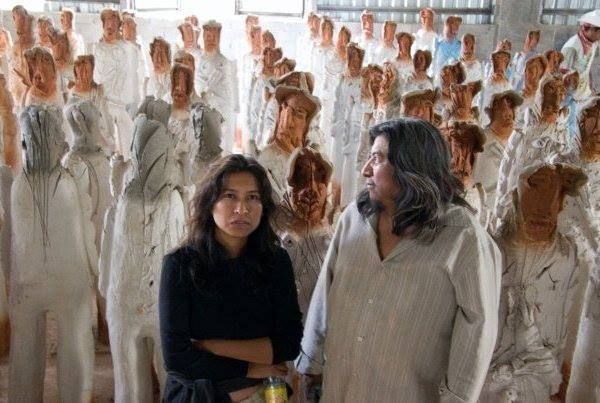
Returning from a three-year stay in Paris to his hometown of Teococuilco, in the southern Mexican state of Oaxaca, painter and sculptor Alejandro Santiago discovered the village practically emptied of its habitants. Thousands of them had left the impoverished state for the United States. Santiago got busy repopulating it. In 2007, his best-known work, "2,501 Migrants", opened in Teococuilco: 2,501 clay statues about four feet and four inches in height and 150 pounds in weight, each with distinct features, each of them meant to stand for the young people who had abandoned a place which for many Mexicans represents a kind of heartland.
Much of the work of Santiago, who died on Monday of a heart attack at age 49, was informed by a similar sense of loss. He was himself a migrant. At age nine, his parents brought him from Teococuilco, a largely Zapotec village, to the city of Oaxaca, the state's capital. In 2003, two years after his return to Mexico from Paris, he decided he wanted to find out first-hand what the migrants who left for the United States had to brave along the way. Not long into the trek across the border, US immigration agents nabbed and repatriated him. Along the border, he saw thousands of crosses hung on the fence by activists to commemorate those who died while trying to make it to the other side. The sight inspired his "2,501 Migrants", which made waves at the Universal Forum of Cultures in 2007 in Monterrey.
HEADLINE: House Judiciary Committee To Hold Hearing On 'Kids Act' For DREAMers
The artist's work was also the object of expositions in the Museum of Contemporary Art in Oaxaca (MACO) and in cities as far away as Brussels, San Francisco and Paris. His last project of note was a mural presented in March of this year to mourn the 2008 murder of Felícitas Martínez and Teresa Bautista, two radio anchors with the community station La Voz. And he was a well-known promoter of the arts in Oaxaca, having created and managed two cultural spaces, La Telaraña (roughly, "The Rat's Nest") and La Calera ("The Kiln").
HEADLINE: Crucial Month Approaching, McCain Says 'We're Not Winning' On Immigration
Gabino Cue, the governor of Oaxaca state, expressed his condolences on Twitter, calling Santiago a "great master and cultural promoter" whose death was an "irreparable loss for Oaxaca and Mexico".
Nuestras condolencias a la familia del gran maestro y promotor cultural, Alejandro Santiago, una pérdida irreparable para #Oaxaca y #México.
— Gabino Cue (@GabinoCue) July 22, 2013
© 2025 Latin Times. All rights reserved. Do not reproduce without permission.




